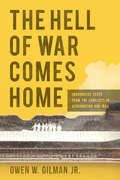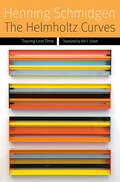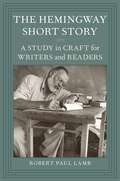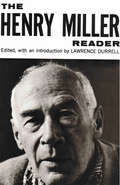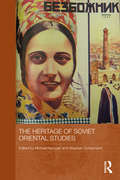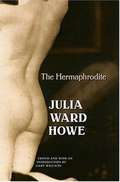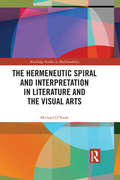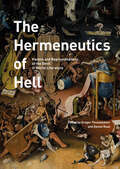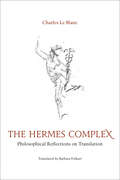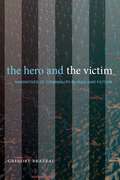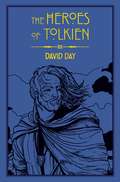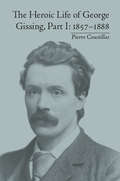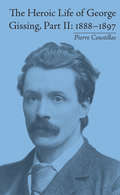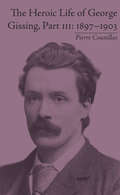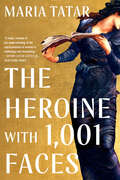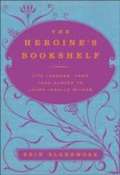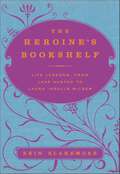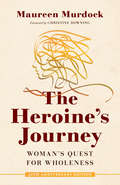- Table View
- List View
The Heirs of Anthony Boucher: A History of Mystery Fandom
by Marvin LachmanThe ultimate collection for mystery fansFollowing in the footsteps of those devoted to science fiction and works about Sherlock Holmes, general mystery fandom emerged in 1967 and has since thrived and become an international phenomenon. With its irresistible combination of puzzle-solving and the examination of the dark underbelly of humanity, crime fiction continues to fascinate and delight millions of readers. Ranging the gamut from cozy mysteries to fast-paced thrillers, crime fiction contains a nearly endless range of books… and, of course, a similarly diverse group of readers who devour them.Out of this rabid readership, countless websites, nearly one hundred fan magazines, and dozens of conferences celebrating mysteries have arisen to bring authors, readers, and fans together. This revised and updated edition of The Heirs of Anthony Boucher is an illuminating look at the history of mystery fandom and its effect on readers across the globe. Complete with anecdotes, personal reminiscences, facts, and pictures, it tells the story of the mystery community's publications and conventions, the fans who produce them, and the future of mystery fandom in years to come.
The Hell of War Comes Home: Imaginative Texts from the Conflicts in Afghanistan and Iraq
by Owen W. Gilman Jr.Owen W. Gilman Jr. stresses the US experience of war in the twenty-first century and argues that wherever and whenever there is war, there will be imaginative responses to it, especially the recent wars in Afghanistan and Iraq. Since the trauma of September 11, the experience of Americans at war has been rendered honestly and fully in a wide range of texts--creative nonfiction and journalism, film, poetry, and fiction. These responses, Gilman contends, have packed a lot of power and measure up even to World War II's literature and film.Like few other books, Gilman's volume studies these new texts-- among them Kevin Powers's debut novel The Yellow Birds and Phil Klay's short stories Redeployment, along with the films The Hurt Locker, American Sniper, and Billy Lynn's Long Halftime Walk. For perspective, Gilman also looks at some touchstones from the Vietnam War. Compared to a few of the big Vietnam books and films, this new material has mostly been read and watched by small audiences and generated less discussion.Gilman exposes the circumstances in American culture currently preventing literature and film of our recent wars from making a significant impact. He contends that Americans' inclination to demand distraction limits learning from these compelling responses to war in the past decade. According to Gilman, where there should be clarity and depth of knowledge, we instead face misunderstanding and the anguish endured by veterans betrayed by war and our lack of understanding.
The Helmholtz Curves: Tracing Lost Time (Forms of Living)
by Henning SchmidgenThis book reconstructs the emergence of the phenomenon of “lost time” by engaging with two of the most significant time experts of the nineteenth century: the German physiologist Hermann von Helmholtz and the French writer Marcel Proust.Its starting point is the archival discovery of curve images that Helmholtz produced in the context of pathbreaking experiments on the temporality of the nervous system in 1851. With a “frog drawing machine,” Helmholtz established the temporal gap between stimulus and response that has remained a core issue in debates between neuroscientists and philosophers.When naming the recorded phenomena, Helmholtz introduced the term temps perdu, or lost time. Proust had excellent contacts with the biomedical world of late-nineteenth-century Paris, and he was familiar with this term and physiological tracing technologies behind it. Drawing on the machine philosophy of Deleuze, Schmidgen highlights the resemblance between the machinic assemblages and rhizomatic networks within which Helmholtz and Proust pursued their respective projects.
The Hemingway Short Story: A Study in Craft for Writers and Readers (Southern Literary Studies)
by Robert Paul LambIn The Hemingway Short Story: A Study in Craft for Writers and Readers, Robert Paul Lamb delivers a dazzling analysis of the craft of this influential writer. Lamb scrutinizes a selection of Hemingway's exemplary stories to illuminate the author's methods of construction and to show how craft criticism complements and enhances cultural literary studies. The Hemingway Short Story, the highly anticipated sequel to Lamb's critically acclaimed Art Matters: Hemingway, Craft, and the Creation of the Modern Short Story, reconciles the creative writer's focus on art with the concerns of cultural critics, establishing the value that craft criticism holds for all readers.Beautifully written in clear and engaging prose, Lamb's study presents close readings of representative Hemingway stories such as "Soldier's Home," "A Canary for One," "God Rest You Merry, Gentlemen," and "Big Two-Hearted River." Lamb's examination of "Indian Camp," for instance, explores not only its biographical contexts -- showing how details, incidents, and characters developed in the writer's mind and notebook as he transmuted life into art -- but also its original, deleted opening and the final text of the story, uncovering otherwise unseen aspects of technique and new terrains of meaning. Lamb proves that a writer is not merely a site upon which cultural forces contend, but a professional in his or her craft who makes countless conscious decisions in creating a literary text.Revealing how the short story operates as a distinct literary genre, Lamb provides the meticulous readings that the form demands -- showing Hemingway practicing his craft, offering new inclusive interpretations of much debated stories, reevaluating critically neglected stories, analyzing how craft is inextricably entwined with a story's cultural representations, and demonstrating the many ways in which careful examinations of stories reward us.
The Henry Miller Reader (Essay Index Reprint Ser.)
by Henry Miller Lawrence DurrellA collection of works spanning the entire career of great 20th-century American writer Henry Miller, edited and introduced by Lawrence Durrell. In 1958, when Henry Miller was elected to membership in the American Institute of Arts and Letters, the citation described him as: "The veteran author of many books whose originality and richness of technique are matched by the variety and daring of his subject matter. His boldness of approach and intense curiosity concerning man and nature are unequalled in the prose literature of our times." It is most fitting that this anthology of "the best" of Henry Miller should have been assembled by one of the first among Miller’s contemporaries to recognize his genius, the eminent British writer Lawrence Durrell. Drawing material from a dozen different books Durrell has traced the main line and principal themes of the "single, endless autobiography" which is Henry Miller’s life work. "I suspect," writes Durrell in his Introduction, "that Miller’s final place will be among those towering anomalies of authorship like Whitman or Blake who have left us, not simply works of art, but a corpus of ideas which motivate and influence a whole cultural pattern." Earlier, H. L. Mencken had said, "his is one of the most beautiful prose styles today," and the late Sir Herbert Read had written that "what makes Miller distinctive among modern writers is his ability to combine, without confusion, the aesthetic and prophetic functions." Included are stories, "portraits" of persons and places, philosophical essays, and aphorisms. For each selection Miller himself prepared a brief commentary which fits the piece into its place in his life story. This framework is supplemented by a chronology from Miller’s birth in 1891 up to the spring of 1959, a bibliography, and, as an appendix, an open letter to the Supreme Court of Norway written in protest of the ban on Sexus, a part of which appears in this volume.
The Heretical Archive: Digital Memory at the End of Film
by Domietta TorlascoThe Heretical Archive examines the relationship between memory and creation in contemporary artworks that use digital technology while appropriating film materials. Domietta Torlasco argues that these digital films and multimedia installations radically transform our memory of cinema and our understanding of the archive. Indeed, such works define a notion of archiving not as the passive preservation of audiovisual signs but as an intervention and the creative rearticulation of cinema&’s perceptual and political textures. Connecting psychoanalysis, phenomenology, and feminist theory in innovative ways, Torlasco analyzes cutting-edge digital works that engage with the past of European cinema and visual culture, including video installations by Monica Bonvicini (Destroy She Said) and Pierre Huyghe (The Ellipsis), Agnès Varda&’s film The Gleaners and I, Marco Poloni&’s multimedia installation The Desert Room, and Chris Marker&’s CD-ROM Immemory. Torlasco&’s central claim is that if the archives of psychoanalysis and cinema have long privileged the lineage that runs from Oedipus to Freud, the archives of the digital age—what she calls the &“heretical archive&”—can help us imagine an unruly, porous, multifaceted legacy, one in which marginal figures return to speak of lost life as much as of life that demands to be lived.
The Heritage Series of Black Poetry, 1962–1975: A Research Compendium
by Lauri RameyIn 1962, the Heritage Series of Black Poetry, founded and edited by Paul Breman, published Robert Hayden's A Ballad of Remembrance. By 1975, the Series had published 27 volumes by some of the twentieth-century's most important and influential poets. As elaborated in Lauri Ramey's extensive scholarly introduction, this innovative volume has dual purposes: To provide primary sources that recover the history and legacy of this groundbreaking publishing venture, and to serve as a research companion for scholars working on the Series and on twentieth-century black poetry. Never-before-published primary materials include Paul Breman's memoir, retrospectives by several of the poets published in the Series, a photo-documentary of W.E.B. Du Bois's 1958 visit to The Netherlands, poems by poets represented in the Series, and scholarly essays. Also included are bibliographies of the Heritage poets and of the Heritage Press Archives at the Chicago Public Library. This reference work is an essential resource for scholars working in the fields of black poetry, transatlantic studies, and twentieth-century book history.
The Heritage of Soviet Oriental Studies (Routledge Contemporary Russia and Eastern Europe Series)
by Michael Kemper Stephan ConermannThis book examines the Russian/Soviet intellectual tradition of Oriental and Islamic studies, which comprised a rich body of knowledge especially on Central Asia and the Caucasus. The Soviet Oriental tradition was deeply linked to politics – probably even more than other European ‘Orientalisms’. It breaks new ground by providing Western and post-Soviet insider views especially on the features that set Soviet Oriental studies apart from what we know about its Western counterparts: for example, the involvement of scholars in state-supported anti-Islamic agitation; the early and strong integration of ‘Orientals’ into the scientific institutions; the spread of Oriental scholarship over the ‘Oriental’ republics of the USSR and its role in the Marxist reinterpretation of the histories of these areas. The authors demonstrate the declared emancipating agenda of Soviet scholarship, with its rhetoric of anti-colonialism and anti-imperialism, made Oriental studies a formidable tool for Soviet foreign policy towards the Muslim World; and just like in the West, the Iranian Revolution and the mujahidin resistance to the Soviet occupation of Afghanistan necessitated a thorough redefinition of Soviet Islamic studies in the early 1980s. Overall, the book provides a comprehensive analysis of Soviet Oriental studies, exploring different aspects of writing on Islam and Muslim history, societies, and literatures. It also shows how the legacy of Soviet Oriental studies is still alive, especially in terms of interpretative frameworks and methodology; after 1991, Soviet views on Islam have contributed significantly to nation-building in the various post-Soviet and Russian ‘Muslim’ republics.
The Hermaphrodite (Legacies of Nineteenth-Century American Women Writers)
by Julia Ward HoweWritten in the 1840s and published here for the first time, Julia Ward Howe's novel about a hermaphrodite is unlike anything of its time-or, in truth, of our own. Narrated by Laurence, who is raised and lives as a man and is loved by men and women alike, yet can respond to neither, this unconventional story explores the realization "that fervent hearts must borrow the disguise of art, if they would win the right to express, in any outward form, the internal fire that consumes them." Laurence describes his repudiation by his family, his involvement with an attractive widow, his subsequent wanderings and eventual attachment to a sixteen-year-old boy, his own tutelage by a Roman nobleman and his sisters, and his ultimate reunion with his early love. <p><p> His is a story unique in nineteenth-century American letters, at once a remarkable reflection of a largely hidden inner life and a richly imagined tale of coming-of-age at odds with one's culture.
The Hermeneutic Spiral and Interpretation in Literature and the Visual Arts (Routledge Studies in Multimodality)
by Michael O'TooleThis collection brings together eighteen of the author’s original papers, previously published in a variety of academic journals and edited collections over the last three decades, on the process of interpretation in literature and the visual arts in one comprehensive volume. The volume highlights the centrality of artistic texts to the study of multimodality, organized into six sections each representing a different modality or semiotic system, including literature, television, film, painting, sculpture, and architecture. A new introduction lays the foundation for the theoretically based method of analysis running through each of the chapters, one that emphasizes the interplay of textual details and larger thematic purposes to create an open-ended and continuous approach to the interpretation of artistic texts, otherwise known as the "hermeneutic spiral". Showcasing Michael O’Toole’s extensive contributions to the field of multimodality and in his research on interpretation in literature and the visual arts, this book is essential reading for students and scholars in multimodality, visual arts, art history, film studies, and comparative literature.
The Hermeneutics of Hell
by Gregor Thuswaldner Daniel RussThis collection of essays analyzes global depictions of the devil from theological, Biblical, and literary perspectives, spanning the late Middle Ages to the 21st century. The chapters explore demonic representations in the literary works of Johann Wolfgang von Goethe, Fyodor Dostoyevsky, Dante Alighieri, Charles Baudelaire, John Milton, H. P. Lovecraft, and Cormac McCarthy, among others. The text examines other media such as the operas Orfeo and Erminia sul Giordano and the television shows Breaking Bad, The Sopranos, and Mad Men. The Hermeneutics of Hell, featuring an international set of established and up-and-coming authors, masterfully examines the evolution of the devil from the Biblical accounts of the Middle Ages to the individualized presence of the modern world.
The Hermeneutics of Postmodernity: Figures and Themes
by G. B. MadisonWhat you, Dear Reader, are about to embark upon is a smorgasbord of ideas. Not just any old smorgasbord, however. Most certainly not one of those which advertise themselves to the unwary customer as offering 250 different specialties "from around the world." No, the smorgasbord offered up here for your delectation is a coherent and consistent one, including only a few select items, like an all-Chinese or all-Swedish one. All the dishes have been prepared in the same mental kitchen, with the same, or complementary, spices and seasonings, and prepared with the same, or complementary, cooking techniques. However, just as some people are not attracted to spicy foods, so some people won't care for what is served up to them here. If, though, you believe that it is high time that philosophy abandoned the stock, fatty concoctions it has traditionally served up in its metaphysical soup kitchens (as William James referred to them), then you should definitely appreciate what is here offered for your dégustation. This book, I say, is like a smorgasbord--in that it is not like a formal, six-course dinner; there is no special order in which the dishes need be consumed.
The Hermes Complex: Philosophical Reflections on Translation (Perspectives on Translation)
by Charles Le BlancWhen Hermes handed over to Apollo his finest invention, the lyre, in exchange for promotion to the status of messenger of the gods, he relinquished the creativity that gave life to his words.The trade-off proved frustrating: Hermes chafed under the obligation to deliver the ideas and words of others and resorted to all manner of ruses in order to assert his presence in the messages he transmitted. His theorizing descendants, too, allow their pretentions to creatorship to interfere with the actual business of reinventing originals in another language.Just as the Hermes of old delighted in leading the traveller astray, so his descendants lead their acolytes, through thickets of jargon, into labyrinths of eloquence without substance.Charles Le Blanc possesses the philosophical tools to dismantle this empty eloquence: he exposes the inconsistencies, internal contradictions, misreadings, and misunderstandings rife in so much of the current academic discourse en translation, and traces the failings of this discourse back to its roots in the anguish of having traded authentic creativity for mere status.
The Hero Is You: Sharpen Your Focus, Conquer Your Demons, and Become the Writer You Were Born to Be (Open Center Book Ser.)
by Kendra LevinConquer writer&’s block, love what you write, and finish what you start with this motivational self-care book for writers. Imagine having your own personal mentor—someone encouraging yet honest, who could help you set and achieve your goals, turn your moments of doubt and fear into sources of strength, and discover what you&’re truly capable of when you&’re at your best. Life coach and publishing industry veteran Kendra Levin is that mentor. And in The Hero Is You, she can help you do the best writing of your life—and live your best life while doing it. With wisdom drawn from her years as a life coach for writers and behind-the-scenes stories from a panoply of bestselling authors, Levin shows you how to become the hero in the narrative of your own process. Offering a fresh approach to Joseph Campbell&’s storytelling archetype, the Hero&’s Journey, The Hero Is You includes more than thirty exercises designed to help you reinvent your creative process from the inside out. This book will show you how to: Identify your biggest challenges and render them powerlessStart a project that you love—and stick with itDesign a structure for writing regularly
The Hero and the Victim: Narratives of Criminality in Iraq War Fiction
by Gregory BrazealTwo decades after the US invasion of Iraq in 2003, a canon of American literature about the war has begun to emerge. Gregory Brazeal’s The Hero and the Victim situates Iraq War fiction in war literature’s broader history. In contrast to the emphasis of most pre-modern war literature on the figure of the warrior-as-hero, and the growing modern emphasis on the figure of the soldier-as-victim, Iraq War fiction reflects the troubled emergence of a new narrative: the story of the ordinary soldier as a wrongdoer or even criminal. To a greater extent than earlier literature about American wars, Iraq War fiction is haunted by depictions of moral injury and expressions of unresolved guilt. The emphasis on soldier criminality in Iraq War fiction can be partly explained by the rise of moral cosmopolitanism and its blurring of the traditional conceptual lines between war and crime. The anti-war literature of the twentieth century often presented fallen soldiers on both sides equally as victims and viewed the distinction between heroes and villains as part of the illusion that battlefield experience strips away. Written in the long shadow of Nuremberg, Iraq War fiction grapples with the possibility that the soldiers on one’s own side may not be the heroes in the story, or even the victims, but participants in a wrong, and perhaps even complicit in crimes. The Hero and the Victim contributes to the ongoing, public reexamination of American traditions by confronting a topic that has, up to now, been largely untouched: the moral celebration of military service. The Hero and the Victim explores the theme of soldier criminality through close readings of several works by American authors, including Kevin Powers’s The Yellow Birds, Phil Klay’s Redeployment, Helen Benedict’s Sand Queen, Chris Kyle’s American Sniper, and Roy Scranton’s War Porn. This volume will be an essential text for students of American literature, historians of war culture, and any scholar interested in representations of the Iraq War.
The Heroes of Tolkien: An Exploration of Tolkien's Heroic Characters, and the Sources that Inspired his Work from Myth, Literature and History
by David DayTolkien's Middle-earth has endured cataclysmic wars and critical battles, causing great men and women to arise and shape the course of its history. In his latest book, best-selling author and Tolkien expert David Day examines the complexities surrounding Tolkien's portrayal of good and evil, analysing the most celebrated heroes from the creation of the world of Arda until the end of the War of the Rings.This work is unofficial and is not authorized by the Tolkien Estate or HarperCollins Publishers.
The Heroes of Tolkien: An Exploration of Tolkien's Heroic Characters, and the Sources that Inspired his Work from Myth, Literature and History (Tolkien)
by David DayIn J. R. R Tolkien's Lord of the Rings, The Hobbit and The Silmarillion, Middle-earth endured cataclysmic wars and critical battles, causing great men, women and mystical creatures to arise, influence and shape the course of its history. Here in this book, Tolkien expert David Day examines the complexities surrounding Tolkien's portrayal of good and evil, and analyses Middle-earth's most celebrated heroes and the literary, historical and mythological sources that inspired their creation.This work is unofficial and is not authorized by the Tolkien Estate or HarperCollins Publishers.
The Heroic Life of George Gissing, Part I: 1857–1888 (The Heroic Life of George Gissing)
by Pierre CoustillasThis ambitious three-volume biography on Gissing examines both his life and writing chronologically and in close detail. Part I covers Gissing’s early life up until his establishment as a writer of moderate critical success.
The Heroic Life of George Gissing, Part II: 1888–1897 (The Heroic Life of George Gissing)
by Pierre CoustillasThis ambitious three-volume biography on Gissing examines both his life and writing both chronologically and in close detail. Part II assesses the period of Gissing’s greatest authorial triumphs. His most critically acclaimed works, The Nether World (1889), New Grub Street (1891) and The Odd Women (1893) date from this time.
The Heroic Life of George Gissing, Part III: 1897–1903 (The Heroic Life of George Gissing)
by Pierre CoustillasThis ambitious three-volume biography on Gissing examines both his life and writing both chronologically and in close detail. This final volume in Coustillas’s prodigious biography examines the turbulent last years of the author’s life and his literary afterlife.
The Heroic Temper: Studies in Sophoclean Tragedy (Sather Classical Lectures #35)
by Bernard M. KnoxThe first two chapters of this book isolate and describe the literary phenomenon of the Sophoclean tragic hero. In all but one of the extant Sophoclean dramas, a heroic figure who is compounded of the same literary elements faced a situation which is essentially the same. The demonstration of this recurrent pattern is made not through character-analysis, but through a close examination of the language employed by both the hero and those with whom he contends. The two chapters attempt to present what might, with a slight exaggeration, be called the "formula" of Sophoclean tragedy.A great artist may repeat a structural pattern but he never really repeats himself. In the remaining four chapters, a close analysis of three plays, the Antigone, Philoctetes, and Oedipus at Colonus, emphasizes the individuality and variety of the living figures Sophocles created on the same basic armature. This approach to Sophoclean drama is (as in the author's previous work on the subject) both historical and critical; the universal and therefore contemporary appeal of the plays is to be found not by slighting or dismissing their historical context, but by an attempt to understand it all in its complexity. "The play needs to be seen as what it was, to be understood as what it is."
The Heroine with 1001 Faces
by Maria TatarWorld-renowned folklorist Maria Tatar reveals an astonishing but long-buried history of heroines, taking us from Cassandra and Scheherazade to Nancy Drew and Wonder Woman. The Heroine with 1,001 Faces dismantles the cult of warrior heroes, revealing a secret history of heroinism at the very heart of our collective cultural imagination. Maria Tatar, a leading authority on fairy tales and folklore, explores how heroines, rarely wielding a sword and often deprived of a pen, have flown beneath the radar even as they have been bent on redemptive missions. Deploying the domestic crafts and using words as weapons, they have found ways to survive assaults and rescue others from harm, all while repairing the fraying edges in the fabric of their social worlds. Like the tongueless Philomela, who spins the tale of her rape into a tapestry, or Arachne, who portrays the misdeeds of the gods, they have discovered instruments for securing fairness in the storytelling circles where so-called women’s work—spinning, mending, and weaving—is carried out. Tatar challenges the canonical models of heroism in Joseph Campbell’s The Hero with a Thousand Faces, with their male-centric emphases on achieving glory and immortality. Finding the women missing from his account and defining their own heroic trajectories is no easy task, for Campbell created the playbook for Hollywood directors. Audiences around the world have willingly surrendered to the lure of quest narratives and charismatic heroes. Whether in the form of Frodo, Luke Skywalker, or Harry Potter, Campbell’s archetypical hero has dominated more than the box office. In a broad-ranging volume that moves with ease from the local to the global, Tatar demonstrates how our new heroines wear their curiosity as a badge of honor rather than a mark of shame, and how their “mischief making” evidences compassion and concern. From Bluebeard’s wife to Nancy Drew, and from Jane Eyre to Janie Crawford, women have long crafted stories to broadcast offenses in the pursuit of social justice. Girls, too, have now precociously stepped up to the plate, with Hermione Granger, Katniss Everdeen, and Starr Carter as trickster figures enacting their own forms of extrajudicial justice. Their quests may not take the traditional form of a “hero’s journey,” but they reveal the value of courage, defiance, and, above all, care. “By turns dazzling and chilling” (Ruth Franklin), The Heroine with 1,001 Faces creates a luminous arc that takes us from ancient times to the present day. It casts an unusually wide net, expanding the canon and thinking capaciously in global terms, breaking down the boundaries of genre, and displaying a sovereign command of cultural context. This, then, is a historic volume that informs our present and its newfound investment in empathy and social justice like no other work of recent cultural history.
The Heroine's Bookshelf: Life Lessons, from Jane Austen to Laura Ingalls Wilder
by Erin BlakemoreIn this compelling book of beloved heroines and the remarkable writers who created them, Blakemore explores how the pluck and dignity of literary characters such as Scout Finch and Jo March can inspire women today.
The Heroine's Bookshelf: Life Lessons, from Jane Austen to Laura Ingalls Wilder
by Erin BlakemoreA testament to inspirational women throughout literature, Erin Blakemore’s exploration of classic heroines and their equally admirable authors shows today’s women how to best tap into their inner strengths and live life with intelligence, grace, vitality and aplomb. This collection of unforgettable characters—including Anne Shirley, Jo March, Scarlett O’Hara, and Jane Eyre—and outstanding authors—like Jane Austen, Harper Lee, and Laura Ingalls Wilder—is an impassioned look at literature’s most compelling heroines, both on the page and off. Readers who found inspiration in books by Toni Morrison, Maud Hart Lovelace, Ursula K. LeGuin, and Alice Walker, or who were moved by literary-themed memoirs like Shelf Discovery and Everything I Needed to Know About Being a Girl I Learned from Judy Blume, get ready to return to the well of women’s classic literature with The Heroine's Bookshelf.
The Heroine's Journey: Woman's Quest for Wholeness
by Maureen MurdockThis book describes contemporary woman's search for wholeness in a society in which she has been defined according to masculine values. Drawing upon cultural myths and fairy tales, ancient symbols and goddesses, and the dreams of contemporary women, Murdock illustrates the need for—and the reality of—feminine values in Western culture today.

